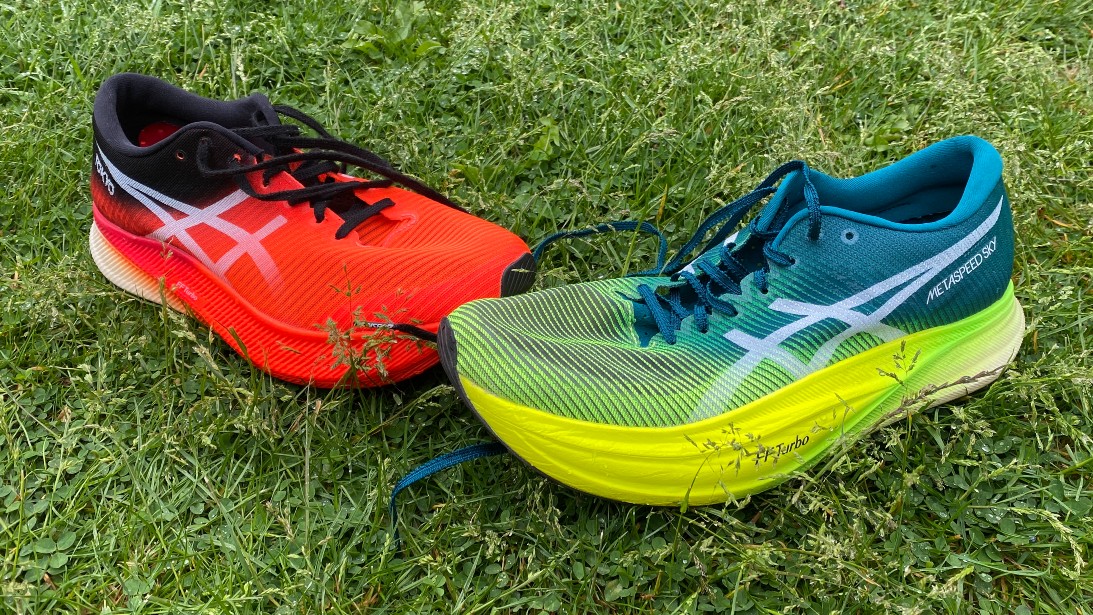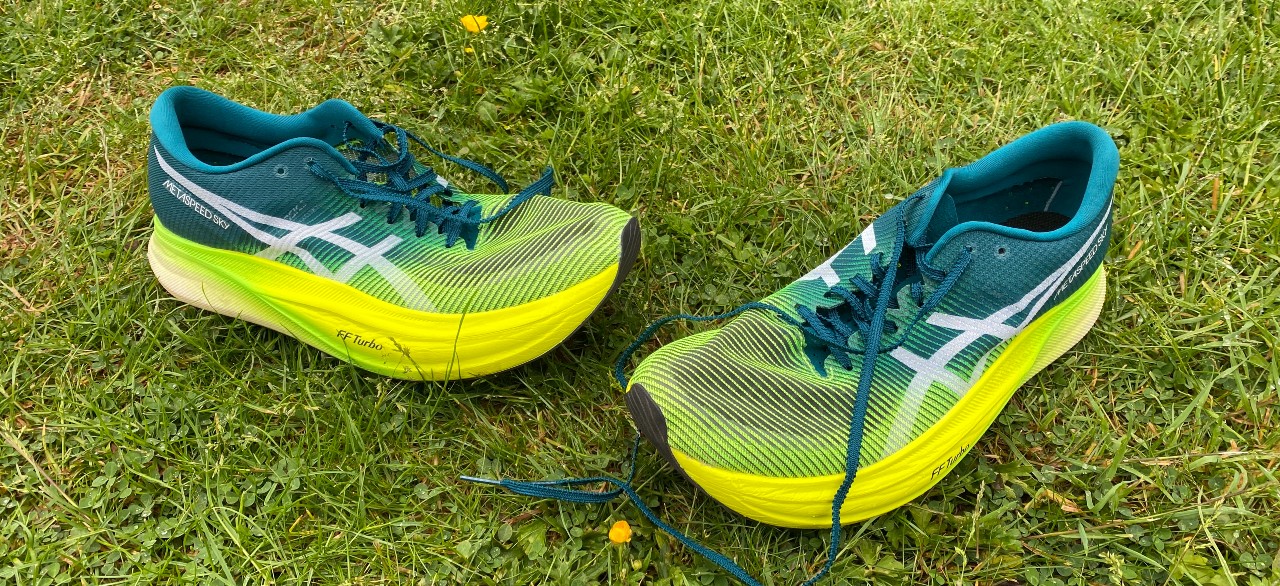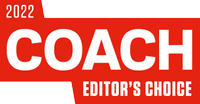Our Verdict
The Asics Metaspeed Sky+ builds on the strong platform set by the original Metaspeed Sky and offers a fast, propulsive ride. It comes closer than most to rivalling the dominance of the Nike Vaporfly NEXT% 2, but you do need to run in a certain way to unlock the Metaspeed Sky+’s full potential.
For
- Lighter than most carbon shoes
- Bouncy and comfortable cushioning
- Carbon plate for added propulsion
Against
- Not enough rubber on outsole
- Best suited to a certain running style
- Low drop won’t suit everyone
You can trust Coach
Although almost every shoe company has now released a carbon plate racing shoe, it’s fair to say that Nike continues to dominate with the Nike Vaporfly NEXT% 2 and Nike Alphafly NEXT%. Most, including myself, still regard these as the best carbon plate running shoes, but Asics provided stiff competition with the launch of the original Metaspeed Sky. With the improvements made to the Metaspeed Sky+, runners have another top-class option to consider for their racing if they don’t want to use the Nike Vaporfly or Alphafly.
Asics Metaspeed Sky+: Price And Availability
The Asics Metaspeed Sky+ was announced in late April and can be viewed on the Asics US and Asics UK websites now, but you can’t actually buy it until 14th June. It costs $250 in the US and £225 in the UK, which is the same price as the original Metaspeed Sky.
Design And Fit
The Metaspeed Sky+ is one of two carbon plate shoes in Asics’s range, the other being the Metaspeed Edge+. This was the same with the original Metaspeed shoes, with Asics designed each to suit a different type of runner.
Asics calls these types “stride” and “cadence” runners. The Sky+ is suited to stride runners who have a bouncy gait and increase their stride length when racing, while the Edge+ is aimed at cadence runners who increase their stride length and cadence when running faster.
The Sky+ has a lower drop than the Edge+ at 5mm versus 8mm, and the carbon plate is placed higher in the midsole to provide more energy return to bouncy runners who put more downward pressure on the midsole with each step. The plate in the Edge+ plate has more of a scoop to encourage a flowing style and faster turnover in cadence runners.

Both shoes have a 39mm heel stack height, which drops to 34mm at the forefoot in the Sky+ and 31mm in the Edge+, and both use the same nylon-based FF Blast foam, which is a little firmer than Nike’s ZoomX but feels similarly springy. The Sky+ has 4% more foam in the midsole than the original Sky: that foam is packed into the forefoot, which is now wider and positively bulges with cushioning.
Despite all that foam the shoe still weighs only 209g/7.4oz, making it one of the lightest carbon plate shoes with a stack that runs up to the 40mm limit set by World Athletics.
Sign up for workout ideas, training advice, reviews of the latest gear and more.
Asics has changed the upper on the Sky+ to a lightweight woven mesh called Motion Wrap. The laces and tongue have also been tweaked to create a better fit. I found that the Sky+ fit me true to size, and my midfoot and heel were held securely.
The outsole has good rubber coverage on the forefoot, but towards the rear there are just two thin strips of rubber on either side that don’t extend all the way back to the heel. This is similar to the outsole pattern of many carbon shoes, which have a lot of exposed foam to reduce weight, but with the Metaspeed Sky and now Sky+ the heel is exposed to the point where heelstriking runners come into contact with the midsole foam and damage it, reducing the durability of the shoe.
After 50km in the Sky+ I have notable wear on the left shoe and while this hasn’t affected performance yet, it does reduce the appeal of the shoe compared with other options if you’re a heelstriker.

How I Tested This Shoe
I have run just over 50km in the Asics Metaspeed Sky+ including a race test at the Edinburgh Half Marathon. I’ve also done some easy and speedy training in the shoe, and I logged around 150km in the original Metaspeed Sky last year.

Running Performance
When the Metaspeed Sky+ landed on my doorstep the day I was due to travel to tackle the Edinburgh Half Marathon it seemed the perfect opportunity to test the shoe in race conditions. After a quick shake-out to make sure the fit was fine and wasn’t going to be uncomfortable over 21.1km, I used it for the race and came away with a two-second PB, logging 1hr 10min 23sec.
During the race the shoe showed off its best qualities. The ride is very bouncy and when I was feeling good, leaning forwards and running well, it felt fantastic. That’s despite the fact I am very much a cadence runner, with a fairly short, shuffle-y style rather than a springy stride runner.
However, when I started to flag or was running into a strong headwind, the shoe lost some of its magic. When you sit back in your stride, don’t lift your knees as high and don’t run with purpose it doesn’t tip you forwards as much as a shoe like the Vaporfly, which has a higher drop and a plate with more of a scooped design.
If I was a bouncy stride runner this might not be the case – I could well be better suited to the Edge+, but it’s a shoe I’m yet to test. I still very much enjoyed racing in the Sky+ and it helped me run at my best in the half marathon, so I wouldn’t necessarily be put off if you don’t fit the running profile Asics has assigned to the shoe.
I also enjoyed using the Metaspeed Sky+ for some general training runs, but given the concerns about durability it’s one I would save for race day and the odd key training session. At 5mm the drop is also lower than most shoes I would regularly use and I did find it put more strain on my calf muscles than shoes with a higher drop, so if you normally use 8-10mm drop shoes that’s something to be aware of.
Is The Asics Metaspeed Sky+ Worth It?

The Asics Metaspeed Sky+ is a top-tier carbon racing shoe and a great option for racing at any distance. The price is high at $250/£225, even for a carbon shoe, but the performance is undoubtedly there, and runners who do fit the stride description may well enjoy the shoe even more than me.
However, the Nike Vaporfly NEXT% 2 is a little cheaper at $225/£209.95 (some colourways cost more, but are still the same as or cheaper than the Metaspeed Sky+), and is now often reduced in price as an older shoe. I still would reach for the Vaporfly over the Metaspeed Sky+ for my main races. Nike’s ZoomX foam is a little springier and the higher drop of the Vaporfly works better for me when I start to flag late in events – another reason to suspect the Metaspeed Edge+ might suit me better.
However, the gap in performance is small, and I rate the Metaspeed Sky+ as better than other great carbon shoes like the Adidas Adios Pro 2 and New Balance RC Elite 2. The Nike Alphafly NEXT% remains the best marathon running shoe in my book and has some similarities to the Metaspeed Sky+, such as a fairly low 4mm heel-to-toe drop, but it feels more cushioned and protective over long distances while still being very quick.

Nick Harris-Fry is a journalist who has been covering health and fitness since 2015. Nick is an avid runner, covering 70-110km a week, which gives him ample opportunity to test a wide range of running shoes and running gear. He is also the chief tester for fitness trackers and running watches, treadmills and exercise bikes, and workout headphones.


